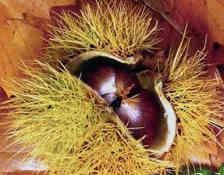 O ur holiday guests came with a bag of chestnuts—exotic, flavourful, enticing. Lacking an open fire, I left them in the plastic bag in which they had been brought. This was a mistake. The nuts had arrived shiny, almost waxy, firm and plump. In a week they had started to shrivel and a few were turning moldy. I had been waiting for the right moment—a little port, someone else with a fireplace—who knows why we procrastinate eating such evanescent luxuries. But the time was now. O ur holiday guests came with a bag of chestnuts—exotic, flavourful, enticing. Lacking an open fire, I left them in the plastic bag in which they had been brought. This was a mistake. The nuts had arrived shiny, almost waxy, firm and plump. In a week they had started to shrivel and a few were turning moldy. I had been waiting for the right moment—a little port, someone else with a fireplace—who knows why we procrastinate eating such evanescent luxuries. But the time was now.
The chestnut season lasts through fall and winter. Most of what we get is imported from Europe. Once they were as common in North America but in the early 1900s they became infected with a fungus disease inadvertently brought into the USA. In a few decades, almost all native American chestnuts—large trees which grew from Maine through Southern Canada and Michigan and as far south as Florida—were wiped out.
The nuts we use as delicacies have been commonly used as an important food. This nutritious nut is an excellent source of fiber, carbohydrates and several minerals and vitamins, particularly C. Like almonds and peanuts, it is high in calories. It has a sweet flavour almost like young corn when it is fresh. Roasted or steamed, the flavour becomes nuttier. European peasant cooking has often substituted the nutritious chestnut flour for wheat or other grains. Soups and other food frequently incorporate ground chestnuts. The larger nuts are sold to be roasted , eaten whole, or used for delicacies such as candied chestnuts. Uneven ones are left to dry and then shelled and milled into flour. The smallest of all are usually fed to livestock. Because they are common at this time of year, they have become traditional Thanksgiving and Christmas foods.
There are several easy ways to cook chestnuts. If you want a strong nutty flavour, simply roast them in a toaster oven at medium-high heat for about 8 minutes. If you want a more subtle flavour, bake them at a lower temperature in an oven for 15 or 20 minutes. In either case, slice them with an X first. Do this by placing the nut on its flat base and cutting across the rounded top. The nuts should open at the cut mark and will be easier to peel. They should be browned on top and still moist and tender within.
For something a little sweeter, cook a half dozen roasted and peeled chestnuts in a cup of water with a half cup of sugar, a dash of vanilla and a capful of maple syrup. Bring this to a boil and let the nuts cook, simmering for about an hour. Remove the chestnuts and set them aside. Boil the syrup to a heavier consistency, pour this over the chestnuts and serve, ideally with some fresh whipped cream, good vanilla ice cream, or even a scoop of freshly packed snow. 
|

